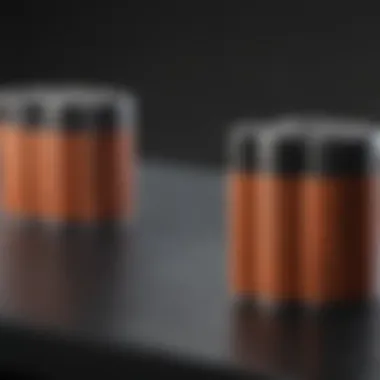Exploring the Edison Iron Battery Innovations and Implications


Intro
The exploration of battery technology has never been more relevant. As energy demands increase, the search for efficient and sustainable energy storage becomes urgent. The Edison Iron Battery emerged as a notable advancement in battery technology during the late 19th century, laying foundational principles still relevant today. This article delves into its innovations and implications, offering a comprehensive understanding of its impact on both historical and contemporary energy systems.
Article Overview
Purpose of the Article
This article aims to uncover the significant aspects of the Edison Iron Battery. We will explore its composition, functionality, and advantages while also considering its historical significance in energy storage evolution. An analysis of its modern applications will also be presented, highlighting its relevance in promoting sustainability in today's energy landscape.
Relevance to Multiple Disciplines
The subject matter intersects various fields, including engineering, environmental science, and history. Its technical specifications offer insights for engineering students and professionals working in the energy sector. At the same time, exploring its implications in sustainability engages environmental scientists and policymakers. Additionally, historians can examine its impact on technological progress and societal development.
Research Background
Historical Context
The Edison Iron Battery was developed in a period characterized by rapid industrial growth and technological advancements. Thomas Edison, an inventor with numerous innovations, saw the potential in improving battery technology. The late 1800s marked a time when energy storage needs were becoming increasingly evident, particularly for electric vehicles and other applications that required reliable power sources.
The design choices Edison made were influenced by the limitations of existing technologies. Traditional batteries, such as lead-acid ones, had inherent drawbacks like weight and toxicity. Edison's motivation was to create a lighter, safer, and more efficient alternative.
Key Concepts and Definitions
Understanding the battery technology begins with key concepts:
- Composition: The Edison Iron Battery uses iron as a core material, supplemented by nickel and other elements. This combination offers robustness and longevity.
- Functionality: Its operation is based on electrochemical reactions similar to conventional batteries, but with enhanced lifespan and depth of discharge.
- Advantages: These include safer materials compared to lead-acid batteries, a longer cycle life, and environmentally friendly disposal options.
"The Edison Iron Battery represents a milestone in energy storage innovation, demonstrating the intersection of practicality and scientific advancement."
"The Edison Iron Battery represents a milestone in energy storage innovation, demonstrating the intersection of practicality and scientific advancement."
In summation, the Edison Iron Battery is more than a historical artifact. It symbolizes the early strides toward modern battery technologies that sustain our current energy frameworks.
Prologue to the Edison Iron Battery
The Edison Iron Battery is an important topic in the field of battery technology. Developed by Thomas Edison in the late 19th century, it offered new possibilities for energy storage. This innovation is not just a footnote in history; it laid groundwork for future advancements in battery technology. Understanding its construction, functionality, and implications helps illuminate the evolution of modern energy systems.
Overview of Battery Technologies
Battery technology has evolved significantly since its inception. At its core, a battery stores energy chemically and converts it to electrical energy upon demand. There are various types of batteries, including lead-acid, lithium-ion, and nickel-cadmium, each having distinct characteristics and applications.
Edison’s approach was unique due to its use of iron and nickel. The Edison Iron Battery consists primarily of nickel plating for the positive terminal, with iron as the negative terminal. This combination offers advantages over other battery types, such as enhanced safety and the potential for reusability. Many technologies today rely on efficient and safe energy storage solutions, highlighting the relevance of Edison's work in ongoing research and development.
Historical Context of Edison’s Innovations
Thomas Edison was a pioneer not only in electric light but also in battery technology. His work in the world of batteries began in earnest around the 1890s. At the time, batteries were often heavy, inefficient, and hazardous. These limitations prompted Edison to seek a more effective solution.
The social and industrial landscapes of the late 19th century influenced his innovations. There was a rising demand for portable energy sources, particularly driven by the growth of electric railway systems and the burgeoning field of electrical engineering. Edison's iron battery promised a reliable, safer, and more cost-effective alternative, paving the way for various applications.
In summary, the Edith Iron Battery is an important piece in the broader puzzle of energy storage. It reflects Edison's relentless pursuit of innovation in a time of great change and technological advancement. As we examine the various aspects of this battery technology, we gain valuable insights into its past, present, and future relevance.
Composition of the Edison Iron Battery
The composition of the Edison Iron Battery is crucial to understanding its innovative technology and potential applications. The materials and design choices made impact its efficiency, durability, and overall performance. This section will explore the key materials used and the unique design features that contribute to its functionality.
Materials Used in Construction
Nickel and Iron
Nickel and iron are the primary materials of the Edison Iron Battery. This choice is significant due to their electrochemical properties. Nickel provides a stable reaction environment while iron is known for its abundance and low cost. The combination yields a battery that is both affordable and effective. Notably, the high charge capacity of nickel enhances the battery's overall energy storage capabilities.
The durability of these materials is another advantage. Nickel resists corrosion, which extends the life of the battery. However, high temperatures can negatively affect performance, making thermal management important.


Electrolyte Solutions
Electrolyte solutions play a vital role in the Edison Iron Battery's operation, facilitating the movement of ions between the electrodes. The use of alkaline electrolyte is common, as it supports efficient chemical reactions. This choice improves the battery's charge-discharge cycle, allowing more efficient energy transfer.
One key characteristic of alkaline electrolyte is its ability to maintain performance over time. However, it is important to monitor the electrolyte concentration to avoid degradation. An imbalance can lead to reduced efficiency, impacting the overall lifecycle of the battery.
Design Features and Mechanics
Cell Configurations
The Edison Iron Battery uses a distinctive cell configuration that enhances its performance. Each cell is designed to maximize surface area, allowing for greater interaction between the electrolyte and electrodes. This facilitates improved energy transfer and increases the overall efficiency of the system.
Additionally, these configurations assist in maintaining uniformity during charge cycles. If not correctly designed, it can lead to hotspots, reducing the battery's lifespan and performance.
Charging Mechanisms
The charging mechanisms of the Edison Iron Battery are advanced and designed for effectiveness. A constant current charging enables faster recharging, which is vital in modern applications. This method allows for quicker turnaround times, making the battery suitable for energy-intensive tasks.
The unique feature of this system is its ability to recover from overcharging due to its robust material properties. However, care must be taken to avoid excessive charging, as it can lead to premature degradation of components, particularly the electrolyte.
Functionality of the Edison Iron Battery
The functionality of the Edison Iron Battery is a crucial aspect of its overall design and application. Understanding how this battery operates helps in recognizing its importance in various energy storage solutions. The Edison Iron Battery utilizes unique chemical reactions and energy storage principles that set it apart from other battery technologies.
Operating Principles
Chemical Reactions
The chemical reactions involved in the Edison Iron Battery are central to its operation. At its core, these reactions occur between iron and nickel, facilitated by an electrolyte solution. When the battery is charged, a series of oxidation-reduction reactions take place, allowing energy to be stored. One of the key characteristics of these reactions is their efficiency. They efficiently convert chemical energy into electrical energy, which is critical in ensuring effective power output.
Moreover, the simplicity of the chemical reactions contributes to the longevity of the battery. This factor is often advantageous in industrial and commercial applications, where reliability is essential. Notably, a disadvantage of these reactions might include sensitivity to extreme conditions, which can affect performance but is generally manageable with proper engineering.
Energy Storage Capacity
Energy storage capacity is another critical aspect of the Edison Iron Battery's functionality. This capacity determines how much energy the battery can hold and supply, which is vital for both stationary and mobile applications. The Edison Iron Battery generally offers a substantial capacity, which allows it to serve as a robust energy source.
A notable characteristic of this battery is its ability to sustain high levels of performance over extended periods, making it a favorable choice for energy-intensive uses. However, one must consider its weight compared to newer technologies, which may present a challenge in some modern applications. This trade-off between capacity and weight must be evaluated when selecting the appropriate battery for specific applications.
Performance Characteristics
Charge and Discharge Rates
The charge and discharge rates of the Edison Iron Battery play a significant role in its usability. These rates indicate how quickly the battery can receive and deliver energy, which is a pivotal factor in applications like electric vehicles. The battery can handle rapid charge and discharge, which is beneficial in high-demand scenarios.
However, a unique challenge with the Edison Iron Battery is its comparatively lower discharge rate than some modern lithium-ion batteries. This limitation does not diminish its value overall, but it does necessitate careful consideration regarding its application. Balancing these rates is essential for optimizing performance in practical situations.
Longevity and Maintenance
Longevity and maintenance needs are strong points of the Edison Iron Battery. This battery type is generally more resistant to degradation compared to more fragile alternatives. It can endure a larger number of charge cycles without a significant drop in performance. Thus, the overall lifespan of the battery becomes an attractive feature for users looking for long-term solutions.
Regular maintenance is still necessary to ensure the efficiency of the battery. This includes checking and replenishing the electrolyte solution as necessary. A notable feature is the accessibility of such maintenance, making it easier for operators to manage over time. On the downside, neglect can lead to reduced performance or even failure of the battery.
The Edison Iron Battery, with its distinctive functionalities, stands as a testament to the ingenuity of early battery technology. Its operational principles have inspired ongoing innovations in energy storage solutions.
The Edison Iron Battery, with its distinctive functionalities, stands as a testament to the ingenuity of early battery technology. Its operational principles have inspired ongoing innovations in energy storage solutions.
Advantages of Edison Iron Battery Technology
The Edison Iron Battery presents unique advantages that set it apart from other battery technologies. Recognizing these benefits is critical for understanding its relevance in both historical and contemporary contexts. The design and innovation behind these batteries offer specific performance benefits, aligning well with the needs of modern energy demands.
Safety Features


One of the most significant advantages of the Edison Iron Battery is its enhanced safety features. Unlike lithium-ion batteries, which can pose risks of overheating and ignition, the Edison Iron Battery uses iron and nickel as primary materials. This composition greatly reduces the risk of fire and explosion. The electrolytic solutions in these batteries are also less volatile, making them safer for operation in various environments.
Moreover, the robust design of the Edison Iron Battery accommodates thermal expansion better than other battery types. This design consideration adds an extra layer of safety, particularly in applications where batteries may undergo temperature fluctuations. Overall, its reliable safety profile makes the Edison Iron Battery suitable for a wide range of uses, from industrial applications to residential energy storage.
Environmental Impact
The environmental considerations of battery technology are paramount, especially in today’s climate-focused discussions. The Edison Iron Battery scores well on this front for several reasons. First, its use of abundant and more eco-friendly materials like iron and nickel reduces the reliance on rare metals, which are often associated with harmful mining practices.
The battery's chemistry is also designed to minimize toxic by-products. When disposed of, the components do not contribute significantly to environmental degradation. In addition, because the Edison Iron Battery has a long cycle life, it necessitates fewer replacements. This characteristic leads to less waste over time, which is an essential factor in promoting sustainability within energy systems.
Cost-Efficient Production
Cost-effectiveness is another key advantage of the Edison Iron Battery technology. The materials used for its construction are more affordable compared to those used in lithium-ion batteries. For instance, sourcing iron and nickel is less expensive, reducing the overall production costs.
Furthermore, the manufacturing processes of Edison Iron Batteries are generally less complex. This efficiency can translate into lower prices for consumers, making energy storage solutions more accessible. The cost-efficient nature of these batteries also allows businesses to achieve better return on investment when implementing energy storage systems in their operations.
"Cost-effective and safer, the Edison Iron Battery represents a pragmatic solution for modern energy needs, aligning with sustainability goals."
"Cost-effective and safer, the Edison Iron Battery represents a pragmatic solution for modern energy needs, aligning with sustainability goals."
In summary, the Edison Iron Battery technology offers several advantages that are increasingly relevant in today’s energy landscape. Its safety features, positive environmental impact, and cost-efficient production methods highlight its potential for broader application in various sectors.
Historical Impact of the Edison Iron Battery
The Edison Iron Battery is not merely a technological artifact; it represents a critical juncture in the development of energy storage solutions. With an emphasis on practicality, safety, and longevity, Edison's creation contributed significantly to the evolution of battery technologies. This section explores the historical significance of the Edison Iron Battery, highlighting Thomas Edison’s contributions and its diverse applications in early technological advancements.
Edison's Role in Battery Development
Thomas Edison played a pivotal role in shaping modern battery technology. He believed that batteries should not only store energy but also be practical and reliable for daily use. In the 1880s, he began experimenting with nickel and iron reactions, which led to the creation of the Edison Iron Battery. Unlike the lead-acid batteries that dominated the market at the time, Edison's design offered improved safety and durability.
Edison's insistence on using materials that could withstand harsh environments and had lower toxicity set a new standard in battery design. His approach was revolutionary, as it focused on delivering not only efficiency but also a form of energy storage that posed less danger to users. By addressing the issues of battery degradation and safety, Edison laid the foundation for future innovations in electrochemical systems.
Applications in Early Technology
The Edison Iron Battery found its way into various sectors, showcasing its versatility and effectiveness. Its introduction marked the beginnings of several applications that would flourish as technology evolved.
Electric Vehicles
In the realm of electric vehicles, the Edison Iron Battery was instrumental in driving the early automobile market. Unlike the less stable batteries of the time, Edison's design offered a reliable energy source that could support continuous use. The key characteristic of the Edison Iron Battery was its ability to sustain longer charge cycles, making it a more viable option for electric vehicles compared to its contemporaries.
One prominent feature was its capacity for deeper discharge, which meant that drivers could utilize a greater portion of the battery's energy without significant damage.
The benefits of this reliability were evident, as it allowed for the development of practical electric vehicles during the early 20th century. Although the market eventually shifted towards more advanced battery systems, the Edison Iron Battery provided essential groundwork for future automotive innovations.
Industrial Use Cases
In industrial applications, the Edison Iron Battery revealed its utility in sectors that required dependable energy storage solutions. Industries, especially those that needed backup power or support for machinery, turned to Edison's invention for its stability and low maintenance needs.
One notable characteristic of the Edison Iron Battery’s design was its durability, which reduced downtime and service interruptions in industrial settings.
Furthermore, these batteries were seen as a cost-saving solution in manufacturing processes, given their long life cycle and the minimal need for replacement. While the market now offers alternatives, the early integration of Edison Iron Batteries into industrial applications highlighted its role in advancing energy efficiency in the workplace.
"Edison's innovations in battery technology paved the way for the future of reliable energy storage."
"Edison's innovations in battery technology paved the way for the future of reliable energy storage."
Contemporary Applications of Edison Iron Batteries
The Edison Iron Battery has significant implications in contemporary energy solutions. Its robust design and functional capabilities offer a unique blend of reliability and sustainability. As the world increasingly turns toward renewable energy, this battery's role becomes crucial. Understanding its applications allows us to appreciate how such technology can innovate energy management systems.
Modern Energy Storage Solutions


Modern energy storage solutions are essential for effectively managing energy supply and demand. Edison Iron Batteries provide a viable option for this need, due to their long lifespan and stability during use. These batteries are known for their ability to be deep-cycled, which means they can be discharged and recharged frequently without degrading significantly. The durability of these batteries makes them suitable for various energy applications, reducing the frequency of replacements.
Integration in Renewable Resources
Integrating Edison Iron Batteries into renewable energy systems enhances efficiency and storage capacities. They offer flexibility and reliability, which is often needed for managing energy generated from fluctuating sources like solar and wind.
Solar Energy Systems
In the context of Solar Energy Systems, Edison Iron Batteries serve to store energy generated during peak sunlight hours. This stored energy can then be utilized when solar generation is low, such as during cloudy days or at night. One notable characteristic is their ability to withstand extreme temperatures without significant performance loss, making them a reliable choice for various climates. This stability is a considerable advantage over other battery types, which may fail under similar conditions.
Ultimately, the efficiency of Edison Iron Batteries in solar energy systems promises not just better energy management but also a contribution to reducing reliance on fossil fuels.
Wind Energy Applications
Similarly, in Wind Energy Applications, these batteries can store surplus energy produced during strong wind events. This feature is beneficial in maintaining a balanced energy distribution, especially when wind generation peaks unexpectedly. A key characteristic of Edison Iron Batteries is their rapid charge and discharge capabilities, which support quick energy usage shifts in response to changes in wind conditions. However, one consideration is their lower energy density compared to lithium-ion batteries, which means they require more space for equivalent storage capacities.
In summary, the practical use of Edison Iron Batteries in renewable resources aligns with global goals for sustainable energy solutions. Their inherent properties cater to a range of scenarios, thus enhancing the reliability of both solar and wind energy systems.
Future Prospects of Battery Technology
The future of battery technology is a critical topic, influencing not just the electronics industry but also renewable energy systems and electric vehicles. As society demands higher efficiency, lower costs, and sustainable options, advancements in battery technology become vital. In this context, understanding future innovations and sustainability efforts will guide progress in energy storage solutions.
Innovations on the Horizon
New Material Research
New material research is gaining attention in battery technology. Researchers aim to identify substitutes for conventional materials like lithium. This movement focuses on materials that enhance battery performance and safety. One key characteristic of new materials is their ability to increase energy density. This makes them suitable for various applications in this article, including electric vehicles and grid storage.
A unique feature of many new materials is their environmental friendliness, making them an attractive option. For instance, sodium-ion batteries have the potential to replace lithium batteries due to the abundance of sodium. However, challenges remain, such as achieving competitive energy density and cycle life compared to traditional options. Thus, while promising, these new materials require further development to maximize their benefits.
Enhanced Efficiency Solutions
Enhanced efficiency solutions are crucial for optimizing battery performance. These solutions focus on improving charge and discharge rates, alongside longevity. One characteristic that stands out is the implementation of advanced battery management systems. Such systems monitor performance and adjust usage to prolong lifespan. This makes them essential for modern battery applications discussed in this article.
A notable feature of enhanced efficiency solutions is their integration with smart technologies. They can provide real-time data to users, which can improve energy management strategies. However, the complexity of these systems may introduce additional costs and require specialized knowledge for installation and maintenance.
Sustainability in Battery Manufacturing
Sustainability in battery manufacturing is becoming increasingly crucial as environmental concerns grow. The industry is under pressure to reduce waste and use eco-friendly materials. This involves adopting practices that minimize carbon footprints and replenish resources. Manufacturers are exploring ways to recycle materials from old batteries, reducing the need for raw materials.
Investments in renewable energy sources for production processes are critical too. Shifting to solar or wind energy in factories could significantly lower emissions.
"Sustainable practices in battery manufacturing can drive both innovation and reduce environmental impact, ensuring that future technologies meet global energy needs without compromising ecological integrity."
"Sustainable practices in battery manufacturing can drive both innovation and reduce environmental impact, ensuring that future technologies meet global energy needs without compromising ecological integrity."
In summary, the future prospects of battery technology hinge on innovative materials and enhanced efficiency solutions. Equally important is the need for sustainability in manufacturing practices. Adapting to these trends will not only optimize battery performance but also secure a more environmentally responsible approach to energy storage.
Closure
The conclusion of this article provides a succinct reflection on the significance of the Edison Iron Battery within both historical and modern contexts. This battery, shaped by Edison's vision, emerged as a powerful response to the energy storage challenges of its time. By evaluating its unique composition, functionality, and ecological advantages, we can understand why the Edison Iron Battery is vital in contemporary energy discussions.
Summarizing Key Points
The Edison Iron Battery holds several noteworthy attributes:
- Innovative Composition: It utilizes iron and nickel, providing a balance of durability and performance.
- Enhanced Functionality: The battery's operation revolves around efficient chemical reactions that promote robust energy storage capabilities.
- Safety and Sustainability: Compared to other battery technologies, the Edison Iron Battery showcases favorable safety features and a lesser environmental impact, which is crucial for today’s practices.
- Historical Relevance: Edison's innovations not only advanced battery technology but also catalyzed growth in electric vehicle applications and industrial scenarios.
These points illustrate not only the capabilities of the Edison Iron Battery but its profound impact on energy solutions.
The Legacy of Edison’s Innovation
The legacy of Edison’s innovation cannot be overstated. His work laid a foundation for future energy storage technologies. The influence of the Edison Iron Battery is evident in several areas:
- Inspiration for Future Innovations: Many modern-day batteries draw inspiration from Edison's principles, demonstrating that his ideas remain relevant.
- Adoption in Renewable Energy: Edison's work has also made its way into current renewable energy systems, where the need for efficient storage solutions is critical.
- Cultural Influence: The Edison Iron Battery serves as a historical benchmark, showcasing the potential for creativity and innovation in solving complex energy problems.
In essence, the legacy of Edison's efforts endures through ongoing advancements in battery technologies and their applications in renewable energy today. The significance of the Edison Iron Battery extends beyond its initial invention, influencing modern practices in sustainability and energy efficiency.



